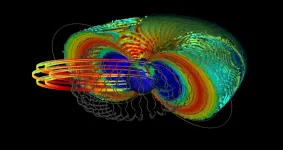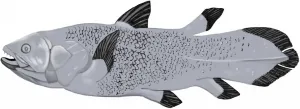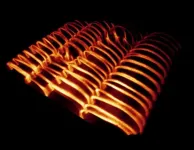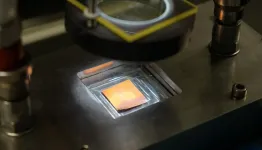How do electrons close to Earth reach almost the speed of light?
New study found that electrons can reach ultra-relativistic energies for very special conditions in the magnetosphere when space is devoid of plasma.
2021-02-02
(Press-News.org) New study found that electrons can reach ultra-relativistic energies for very special conditions in the magnetosphere when space is devoid of plasma.
Recent measurements from NASA's Van Allen Probes spacecraft showed that electrons can reach ultra-relativistic energies flying at almost the speed of light. Hayley Allison, Yuri Shprits and collaborators from the German Research Centre for Geosciences have revealed under which conditions such strong accelerations occur. They had already demonstrated in 2020 that during solar storm plasma waves play a crucial role for that. However, it was previously unclear why such high electron energies are not achieved in all solar storms. In the journal Science Advances, Allison, Shprits and colleagues now show that extreme depletions of the background plasma density are crucial.
Ultra-relativistic electrons in space
At ultra-relativistic energies, electrons move at almost the speed of light. Then the laws of relativity become most important. The mass of the particles increases by a factor ten, time is slowing down, and distance decreases. With such high energies, charged particles become most dangerous to even the best protected satellites. As almost no shielding can stop them, their charge can destroy sensitive electronics. Predicting their occurrence - for example, as part of the observations of space weather practised at the GFZ - is therefore very important for modern infrastructure.
To investigate the conditions for the enormous accelerations of the electrons, Allison and Shprits used data from a twin mission, the "Van Allen Probes", which the US space agency NASA had launched in 2012. The aim was to make detailed measurements in the radiation belt, the so-called Van Allen belt, which surrounds the Earth in a donut shape in terrestrial space. Here - as in the rest of space - a mixture of positively and negatively charged particles forms a so-called plasma. Plasma waves can be understood as fluctuations of the electric and magnetic field, excited by solar storms. They are an important driving force for the acceleration of electrons.
Data analysis with machine learning
During the mission, both solar storms that produced ultra-relativistic electrons and storms without this effect were observed. The density of the background plasma turned out to be a decisive factor for the strong acceleration: electrons with the ultra-relativistic energies were only observed to increase when the plasma density dropped to very low values of only about ten particles per cubic centimetre, while normally such density is five to ten times higher.
Using a numerical model that incorporated such extreme plasma depletion, the authors showed that periods of low density create preferential conditions for the acceleration of electrons - from an initial few hundred thousand to more than seven million electron volts. To analyse the data from the Van Allen probes, the researchers used machine learning methods, the development of which was funded by the GEO.X network. They enabled the authors to infer the total plasma density from the measured fluctuations of electric and magnetic field.
The crucial role of plasma
"This study shows that electrons in the Earth's radiation belt can be promptly accelerated locally to ultra-relativistic energies, if the conditions of the plasma environment - plasma waves and temporarily low plasma density - are right. The particles can be regarded as surfing on plasma waves. In regions of extremely low plasma density they can just take a lot of energy from plasma waves. Similar mechanisms may be at work in the magnetospheres of the outer planets such as Jupiter or Saturn and in other astrophysical objects", says Yuri Shprits, head of the GFZ section Space physics and space weather and Professor at University of Potsdam.
"Thus, to reach such extreme energies, a two-stage acceleration process is not needed, as long assumed - first from the outer region of the magnetosphere into the belt and then inside. This also supports our research results from last year," adds Hayley Allison, PostDoc in the Section Space physics and space weather.
INFORMATION:
[Attachments] See images for this press release:

ELSE PRESS RELEASES FROM THIS DATE:
2021-02-02
The COVID-19 pandemic has upended many parts of daily life, one of them being our work life. Research carried out by the Universitat Oberta de Catalunya (UOC) has studied the factors that help make efficient work teams. The explanation is multidimensional and multilevel.
"Inspiring leadership builds employees' resilience and willingness to undertake new challenges," said Pilar Ficapal Cusi, professor at the UOC's Faculty of Economics and Business and one of the authors of the study, which was published in the Journal of Cleaner Production.
Viewed from the group and organizational perspective, "the shared vision, the team's belief in its own creative effectiveness, the ability to reflect openly about how their members connect to adapt ...
2021-02-02
Researchers at Lund University in Sweden have discovered the individual traits of fungi, and how their hyphae - that is, the fungal threads that grow in soil - behave very differently as they navigate through the earth's microscopic labyrinths.
The study was performed in a lab environment, and the underground system constructed synthetically from silicone. Using a microscope, researchers were able to follow seven species and compare their behaviour. How do they react when the maze they grow in turns sharply and forces the hyphae to grow in the direction it came from? What happens when a large space opens up in front of them?
"Under a microscope, their behaviour becomes much more personal than you can ever imagine. ...
2021-02-02
Parasitic worms could hold the key to living longer and free of chronic disease, according to a review article published today in the open-access eLife journal.
The review looks at the growing evidence to suggest that losing our 'old friend' helminth parasites, which used to live relatively harmlessly in our bodies, can cause ageing-associated inflammation. It raises the possibility that carefully controlled, restorative helminth treatments could prevent ageing and protect against diseases such as heart disease and dementia.
"A decline in exposure to commensal microbes and gut helminths in developed countries ...
2021-02-02
A greater exposure to air pollution at the very start of life was associated with a detrimental effect on people's cognitive skills up to 60 years later, the research found.
Researchers at the University of Edinburgh tested the general intelligence of more than 500 people aged approximately 70 years using a test they had all completed at the age of 11 years.
The participants then repeated the same test at the ages of 76 and 79 years.
A record of where each person had lived throughout their life was used to estimate the level of air pollution they had experienced in their early years.
The team used statistical models to analyse the relationship between a person's exposure to air pollution ...
2021-02-02
To evaluate the chemical composition of food from a physiological point of view, it is important to know the functions of the receptors that interact with food ingredients. These include receptors for bitter compounds, which first evolved during evolution in bony fishes such as the coelacanth. What 400 million years of evolutionary history reveal about the function of both fish and human bitter receptors was recently published in the journal Genome Biology and Evolution by a team of researchers led by the Leibniz Institute for Food Systems Biology at the Technical University of Munich and the University of Cologne.
Evolutionarily, bitter receptors are a relatively recent invention of nature compared ...
2021-02-02
A process that releases iron in response to stress may contribute to heart failure, and blocking this process could be a way of protecting the heart, suggests a study in mice published today in eLife.
People with heart failure often have an iron deficiency, leading some scientists to suspect that problems with iron processing in the body may play a role in this condition. The study explains one way that iron processing may contribute to heart failure and suggests potential treatment approaches to protect the heart.
"Iron is essential for many processes in the body including oxygen transport, but too much iron can lead to a build-up of unstable oxygen molecules that can kill cells," says ...
2021-02-02
Trees are by far the tallest organisms on Earth. Height growth is made possible by a specialized vascular system that conducts water from the roots to the leaves with high efficiency, while simultaneously providing stability. The so-called xylem, also known as wood, is a network of hollow cells with extremely strong cell walls that reinforce the cells against the mechanical conflicts arising from growing tall. These walls wrap around the cells in filigree band and spiral patterns. So far, it is only partly known, how these patterns are created. Scientists from the Max Planck Institute for Molecular Plant Physiology in Golm/Potsdam and from ...
2021-02-02
Carbon dioxide (CO2) is one of the major greenhouse gases causing global warming. If carbon dioxide could be converted into energy, it would be killing two birds with one stone in addressing the environmental issues. A joint research team led by City University of Hong Kong (CityU) has developed a new photocatalyst which can produce methane fuel (CH4) selectively and effectively from carbon dioxide using sunlight. According to their research, the quantity of methane produced was almost doubled in the first 8 hours of the reaction process.
The research was led by Dr Ng Yun-hau, Associate Professor in the ...
2021-02-02
King Richard III's involvement in one of the most notorious and emotive mysteries in English history may be a step closer to being confirmed following a new study by Professor Tim Thornton of the University of Huddersfield.
Richard has long been held responsible of the murder of his nephews King Edward V and his brother, Richard, duke of York - dubbed 'the Princes in the Tower' - in a dispute about succession to the throne. The pair were held in the Tower of London, but disappeared from public view in 1483 with Richard taking the blame following his death two years later.
It has become of the most ...
2021-02-02
In the United States only about 1.3 percent of all vehicles sold last year were battery powered. And about 90 percent of those sales were by one company -- Tesla. What has Tesla done right and where have other electric vehicle makers gone wrong?
Electric vehicles cannot succeed without developing a nationwide network of fast-charging networks in parallel with the cars. Current EV business models are doomed unless manufacturers that have bet their futures on them, like General Motors and VW, invest in or coordinate on a robust supercharger network. These are the observations in an in-depth study of the industry by management professors at the University of California, Davis, and Dartmouth College.
The researchers explain that big ...
LAST 30 PRESS RELEASES:
[Press-News.org] How do electrons close to Earth reach almost the speed of light?
New study found that electrons can reach ultra-relativistic energies for very special conditions in the magnetosphere when space is devoid of plasma.




